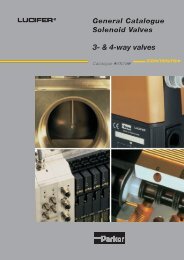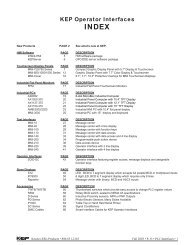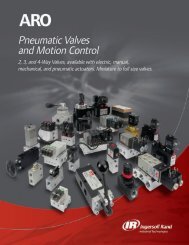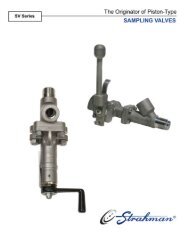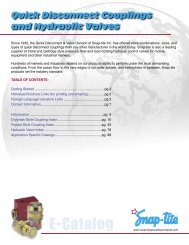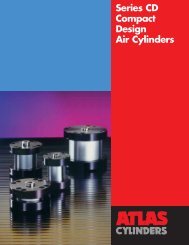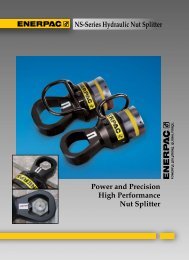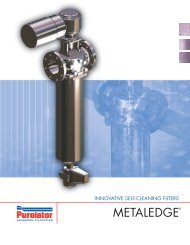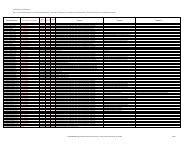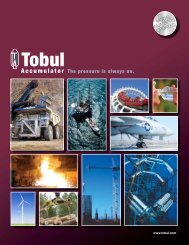Pneumatic Cylinders - Norman Equipment Co.
Pneumatic Cylinders - Norman Equipment Co.
Pneumatic Cylinders - Norman Equipment Co.
Create successful ePaper yourself
Turn your PDF publications into a flip-book with our unique Google optimized e-Paper software.
<strong>Pneumatic</strong> <strong>Cylinders</strong>Developing SpecificationsCalculating the Proper Bore SizeA cylinder’s bore size determines the force it will produce at a given supplypressure. The weight of the load or the clamping force required will largelydetermine the force requirements of the cylinder, and hence, the bore sizerequired. But before determining the appropriate bore size you mustcompensate for air pressure drop, packing friction and load variations usingthe following computation:A) <strong>Co</strong>mpensating for Pressure Drop – Decrease the line pressure value by15 p.s.i. This compensates for pressure drop in the system.Operating pressure (psig) = Line pressure (psig) less 15 (psigpressure drop)Example: If the line pressure is 95 (psig), subtract 15 (psig) toobtain 80 (psig) operating pressure (for sizing purposes).Air pressure atsource. 95 psipressure loss in linesPackingFrictionDownstream pressurebecause of pressureloss in lines:80 psiLoadFrictionThis illustration shows a pressure loss of 15 PSI throughthe airlines and points out friction factors, both of whichmust be compensated for.LOADB) <strong>Co</strong>mpensating for Packing Friction – Before you begin selecting a cylinder you already know the weight of the load youmust move or the clamping force you must apply. Multiply this force or load value by 1.25. This compensates forpacking friction and load variations. (If speed is of concern for your application, multiply the force value by 2.0.)Force required (in pounds) = 1.25 x load (or required clamping force)Example: If cylinder must move 100 pound load, multiplying 100 pounds by 1.25 = 125 pounds force required.Now, at the top of the chart on the next page, find the column with the operating pressure calculated in “A” above (in thisexample, 80 psig). Go down that column until you find the force requirement calculated in “B”, above (or the next highervalue). Note that the force values in bold type represent the extend force while those in standard type represent retract force(retract force is lower because the rod reduces the effective piston area). Choose the appropriate value, then go to theCylinder Bore column to find the bore requirements for your application.Now that you know the cylinder bore size that will produce the force required for your application, go to page 7 to determinerod size requirements.Air consumption for each cylinder bore size can be found in the chart below.Cylinder Air <strong>Co</strong>nsumptionTo calculate the air consumption of a cylinder, multiply the total inches of stroke(extend plus retract) by the cycles per minute times the SCFM factor from the chartbelow. To find the SCFM factor, find your gauge pressure in the left hand column.Next, find your cylinder bore size in the chart. Where the two intersect, read down tothe SCFM factor at the bottom of the chart.2-inch cylinderGAUGE PRESSURE – PSIG200180160140120100806040201/2" BORE3/4" BORE1-1/8" BORE1-1/2" BORE2" BORE2-1/2" BORE3" BORE3-1/4" BORE4" BORE5" BORE6" BORE8" BORE251 poundsof force5/8-inch diameter227 pounds of forceGiven equal pressure on both sides ofa piston, the surface area on the extendside will provide greater force..001 .0015 .002 .003 .004 .006 .008 .01 .015 .02 .03 .04 .06 ..08 .10 .15 .20 .30 .40 ..60CU. FT. FREE AIR – (SCFM FACTOR)5



